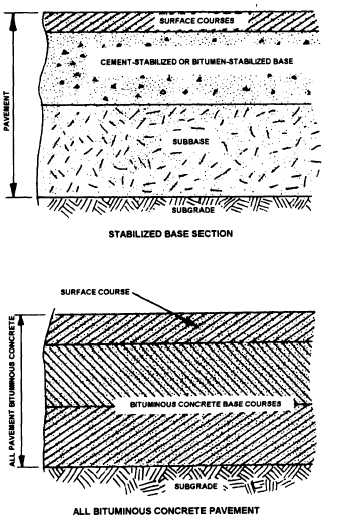LANDING STRIP. Includes the landing area, end
zones, shoulders, and cleared areas.
REVETMENT. A protective pen usually made by
excavating into the side of a hill or by constructing earth,
timber, sandbag, or masonry traverse around the
hardstands. Such pens provide protection against bomb
fragments from high-altitude bombing but provide little
protection against ground strafing. They may actually
draw this type of fire if they are not well concealed.
RUNWAY. That portion of the landing strip, usually
paved, that is used for the landing and takeoff of aircraft.
SHOULDER. The graded and stabilized area
adjacent to the runway or taxiway. Although it is made
capable of supporting aircraft and auxiliary equipment
(such as crash trucks) in emergencies, its principal
function is to facilitate surface drainage.
TAXIWAY. A specially prepared area over which
aircraft may taxi to and from the landing area.
TRANSITION SURFACE. A sloping plane
surface (about 1 foot rise to 7 feet run) at the edge of a
landing strip. Its function is to provide lateral safety
clearances for planes that accidental] y run off the strip.
(See fig. 3-15.)
PLANNING AN AIRFIELD
Planning for aviation facilities requires special
consideration of the type of aircraft to be
accommodated; physical conditions of the site,
including weather conditions, terrain, soil, and
availability y of construction materials; safety factors,
such as approach zone obstructions and traffic control;
the provision for expansion; and defense. Under
wartime conditions, tactical considerations are also
required. All of these factors affect the number,
orientation, and dimensions of runways, taxiways,
aprons, hardstands, hangars, and other facilities.
SUBBASE AND BASE COURSE
Pavements (including the surface and underlying
courses) may be divided into two classes—rigid and
flexible. The wearing surface of a rigid pavement is
constructed of portland cement concrete. Its flexural
strength enables it to act as abeam and allows it to bridge
over minor irregularities in the base or subgrade upon
which it rests. All other pavements are classified as
flexible. Any distortion or displacement in the subgrade
of a flexible pavement is reflected in the base course and
upward into the surface course. These courses tend to
conform to the same shape under traffic. Flexible
pavements are used almost exclusively in the theater of
Figure 3-17.-Typical pavements using stabilized layers.
operations for road and airfield construction since they
adapt to nearly all situations and can be built by any
construction battalion unit in the Naval Construction
Force (NCF).
FLEXIBLE PAVEMENT STRUCTURE
A typical flexible pavement is constructed as shown
in figure 3-16, which also defines the parts or layers of
pavement. All layers shown in the figure are not present
in every flexible pavement. For example, a two-layer
structure consists of a compacted subgrade and a base
course only. Figure 3-17 shows a typical flexible
pavement using stabilized layers. (The word pavement,
when used by itself, refers only to the leveling, binder,
and surface course, whereas flexible pavement refers to
the entire pavement structure from the subgrade up.)
The use of flexible pavements on airfields must be
limited to paved areas not subjected to detrimental
effects of jet fuel spillage and jet blast. In fact, their use
is prohibited in areas where these effects are severe.
3-17

